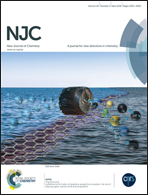Hydrothermal treatment of a TiO2 film by hydrochloric acid for efficient dye-sensitized solar cells
Abstract
The photovoltaic properties of nanoporous TiO2 films treated by different hydrochloric acid (HCl) concentrations were investigated in dye-sensitized solar cells (DSSCs). The nanostructure of the films was reformed, and the thickness decreased after the HCl hydrothermal treatment, which was observed by SEM analysis. It was found that the electron lifetime, band gap, recombination rate and TiO2 film electron injection efficiency had been changed by the processing when different analysis methods were employed to analyze the experimental results, including OCVD, UV-Vis and Mott–Schottky plots. In addition, the schematic for electron transfer and recombination was shown to discuss the process in clear detail. The performance of the DSSCs based on the different TiO2 films was measured by J–V curves and IPCE. When the TiO2 film was treated by 1 mol L−1 HCl at 180 °C for 3 h, the device had the optimum 7.77% photo-electric conversion performance and 16.04 mA cm−2Jsc. The results suggested that the reformed film nanostructure led to an optimized electron transportation pathway, and the decreased electron recombination and increased injection efficiency resulted in improved DSSCs.


 Please wait while we load your content...
Please wait while we load your content...